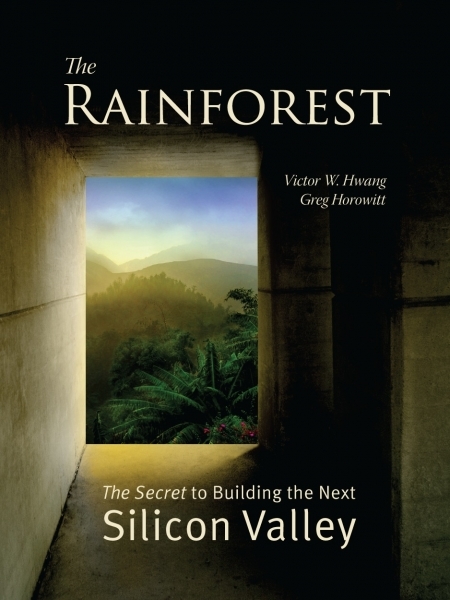After my introductory post about The Rainforest – The Secret to Building the Next Silicon Valley by Victor W. Hwang and Greg Horowitt, which focused on the importance of trust, here is a second piece about culture. The final part will describe how the authors claim they know the recipe to build rainforests. What is remarkable with the Rainforest is the ambition to explain that innovation is mostly cultural so that at the micro-level it cannot really be engineered, but at the macro-level rainforests can be built. I am not sure the authors are right, but the effort is really to be recognized.
One lesson of the Rainforest is that outcomes cannot be engineered. […] Serendipity itself cannot be engineered but an environment that is conducive to serendipity can be. [Page 65]
In their chapter 3 about People, they begin with Keystones, not Entrepreneurs. “What defines a Keystone? Over the years, we have observed certain individuals practicing a unique manner of human interaction that is critical to the growth of entrepreneurial innovation. […] These people are usually missing, or at least too scarce, in almost all regions that have failed at generating significant amounts of entrepreneurial innovation.” [Page 71]
These people are integrative, influential and impactful, they are brokers of social trust (by contrast to entrepreneurs who are people who absorb information, learn from practice and seek opportunities). “The San Francisco Bay Area has a vastly higher percentage of people who are involved in multiple firms. 4.5% of the actors counted in the Bay Area were involved in three or more startups, compared to 2.9% in Boston, 2% in San Diego, […] 1.2% in Austin […] 0.7% in Portland. […] The bay Area has a significantly higher share of individuals who are extremely connected and contribute to the growth of multiple startup ventures”. [Page 74]
The authors also show the diversity of psychologies, the diversity of backgrounds in people which are still connected and work together. “We see these unconscious behaviors at work with innovators everywhere in the world. Scientists versus entrepreneurs. Startups versus large corporations. Investors versus investees. These tribal conflicts can be obstacles to the development of Rainforests.” [Page 109] All the more that: “Similarly the process of building a startup company is one in which people must often rely on gut-level decision-making. Entrepreneurial innovation, by its nature, is virtually a never-ending series of educated guesses. Almost every decision is based substantially incomplete information.” [Page 106]
America is the building of a society not burdened by historical tribes. […] They are less chained to the past. Instead Americans tend to be identified by self-reliance. […] People still run to California today. It is commonly regarded as the land of pioneers, nonconformists, artists, and rebels. [Page 116] Culture is critical to the way economic systems function because it provides the rules of engagement between people that hopefully can maximize their collective well-being. [Page 118] The authors are not naïve but claim that all these people need to find the right balance. A venture capitalist is caught between trying to own as much of a company as possible and trying to leave enough equity in the hands of the entrepreneurial team to keep them fully incentivized. […] A VC wants to preserve a reputation. [Page 119] Innovative behavior is not driven by rational maximization. There are in fact other forces, which can be called extra-rational: competition, altruism, adventure, discovery, creativity, meaning, concern.
Here I cannot avoid mentioning the great (counter-)example of Orson Welles about the Scorpio and the Turtle… Hopefully nature is not everything, culture matters.
One mistake of policy makers is to underestimate these extra-rational motivations. “Governments and corporations often try to incentivize innovation by focusing on financial mechanisms, such as tax breaks, subsidies, grants and loans. But overall, this strategy has been poor. They cannot be only the ends in themselves.” [Page 127]
Traditional incentives, benefits and costs: [Page 124]
Benefits:
Some possibility of making more money
Costs
Sacrifice a stable income and career perhaps forever
Risk social disapproval from family, friends, potential spouses
Difficulty and fear of working with strangers outside conventional circles of trust, culture, ethnicity, language
Difficulty and extra effort in communicating effectively
Huge investment of time, effort, stress
Possibility of losing everything (depending on laws, regarding bankruptcy, partnerships, etc.)
Rainforest incentives, benefits and costs: [Page 126]
Benefits:
Perceived and possibly real opportunity of making more money (following role models that have validated the path already)
Joy of discovery, novelty, adventure, creativity, passion
Social approval (as a peer member of a community of innovators)
Joy of friendship, sharing, love working on a team, building new trust, common values and goals
Fulfillment from the possibility of making a difference in society, leaving a legacy for future generations
Thrill of competition
Freedom and independence
Costs
Little social punishment, often encouragement, from family and friends for taking a worthwhile risk
Some anxiety from meeting new people, but offset by the joy of making new friendships
Huge investment of time, effort, and stress, but viewed in a neutral or even positive light because pursuing a personal passion
Little risk of losing everything because new opportunities emerge in the process of experimentation
Much lower probability of failure from a broad community of fellow innovators.
And the authors claim what are needed are 7 rules [Page 156]:
– Break the rules and dream
– Open doors and listen
– Trust and be trusted
– Experiment and iterate together
– Seek fairness, not advantage.
– Err, fail and persist.
– Pay it forward.
People usually think of Silicon Valley as an anomaly in the otherwise “normal” history of the world, but what if we reversed that proposition? What if we envisioned Silicon Valley as the natural endpoint of a 50,000-year story? Perhaps it could be the latest stage in the evolution of human society, from a culture based on tribes to a culture based on pragmatic individuals. [page 152]
Look at Harari again if you have not not already…

